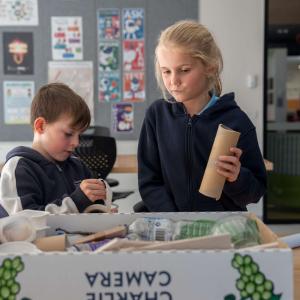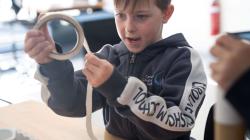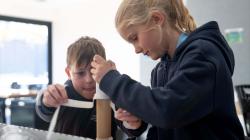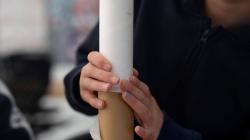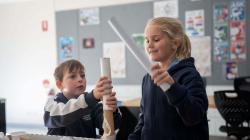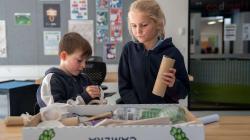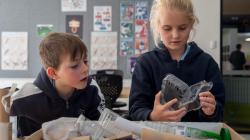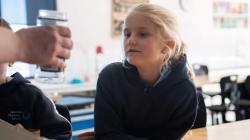'Take, shape and create' is one of our new teaching sequences for AC V9
- On the 'Sequence overview' tab you'll find all the lessons in this sequence and curriculum alignment.
- The 'Our design decisions' tab shows how key scientific ideas develop over the sequence, and shows how the sequence addresses curriculum achievement standards.
- The 'Preparing for this sequence' tab guides you through important information and considerations for this sequence.
- Have you taught this sequence? Use the Feedback button to let us know how it went!
Launch
Lesson 1 • How can we change familiar objects?
Students are introduced to the core concept and context—creating 3D sculptures by physically changing materials.
Inquire
Lesson 2 • What changes?
Students explore the effects of different physical actions (changes) on different materials to determine if the materials are flexible.
Lesson 3 • Elastic plastic?
Students explore the effects of different physical actions on different types of plastic, to determine if plastic is both flexible and elastic.
Lesson 4 • What could wood do?
Students explore the effects of bending wood in order to determine if or when wood is flexible.
Lesson 5 • What can paper do?
Students explore the effects of folding paper, and how being folded might change its strength.
Lesson 6 • What happens to playdough when it is left exposed to air?
Students explore how the properties of playdough change as it dries out.
Act
Lesson 7 • Changing materials to build a sculpture
Students consolidate their learning by designing and making a sculpture that uses everyday materials that have been physically changed.
The Australian Academy of Science supports and encourages broad use of its material. Unless indicated below, copyright material available on this website is licensed under a Creative Commons Attribution-NonCommercial-ShareAlike 4.0 International (CC BY-NC-SA 4.0) licence.
Curriculum and syllabus alignment
Achievement standards
By the end of Year 2 students identify ways to change materials without changing their material composition. They describe how people use science in their daily lives and how people use patterns to make scientific predictions.
Students pose questions to explore observed patterns or relationships and make predictions based on experience. They suggest steps to be followed in an investigation and follow safe procedures to make and record observations. They use provided tables and organisers to sort and order data and represent patterns in data. With guidance, they compare their observations with those of others, identify whether their investigation was fair and identify further questions. They use everyday and scientific vocabulary to communicate observations, findings and ideas.
Australian Curriculum V9 alignment
Science as a human endeavour
Describe how people use science in their daily lives, including using patterns to make scientific predictions
Science understanding
Recognise that materials can be changed physically without changing their material composition and explore the effect of different actions on materials including bending, twisting, stretching and breaking into smaller pieces
Science inquiry
Pose questions to explore observed simple patterns and relationships and make predictions based on experiences
Sort and order data and information and represent patterns, including with provided tables and visual or physical models
Compare observations with predictions and others observations, consider if investigations are fair and identify further questions with guidance
Write and create texts to communicate observations, findings and ideas, using everyday and scientific vocabulary
Australian curriculum content links
| Science understanding core concept: Substances change, these changes involve energy transfer and transformation. |
| Sub-strand | Content descriptor | AC code | Achievement Standard | How the sequence addresses this content |
| SHE: Use and influence of science | Describe how people use science in their daily lives, including using patterns to make scientific predictions. | AC9S2H01 | Describe how people use science in their daily lives and how people use patterns to make scientific predictions. | Describe how physically changing materials might have an impact on how people are able to use them. (Lessons 1-6) |
| SU: Chemical sciences | Recognise that materials can be changed physically without changing their material composition and explore the effect of different actions on materials including bending, twisting, stretching and breaking into smaller pieces. | AC9S2U03 | Identify ways to change materials without changing their material composition. | Identify and explain how, although the material may have been physically changed, it is still the same material. (Lessons 1-7) |
| SI: Questioning and predicting | Pose questions to explore observed simple patterns and relationships and make predictions based on experiences. | AC9S2I01 | Pose questions to explore observed patterns or relationships and make predictions based on experience. | Pose questions about changes to materials. (Lessons 2-6) Predict what might happen when materials are changed. (Lessons 3, 4, 5) |
| SI: Planning and conducting | Suggest and follow safe procedures to investigate questions and test predictions. | AC9S2I02 | Suggest steps to be followed in an investigation and follow safe procedures to make and record observations. | Follow investigation procedure in a safe manner. (Lessons 1-6) |
| SI: Planning and conducting | Make and record observations, including informal measurements, using digital tools as appropriate. | AC9S2I03 | Use scaffolds to plan safe investigations and fair tests. | Record observations using tables. (Lesson 3-6) |
| SI: Processing, modelling and analysing | Sort and order data and information and represent patterns, including with provided tables and visual or physical models. | AC9S2I04 | Use provided tables and organisers to sort and order data and represent patterns in data. | Record observations using tables. (Lesson 3-6) |
| SI: Evaluating | Compare observations with predictions and others’ observations, consider if investigations are fair and identify further questions with guidance. | AC9S2I05 | With guidance, compare observations with those of others, identify whether their investigation was fair and identify further questions. | Discuss investigations results, consider other teams’ results, and compare them to reach an agreed understanding. (Lessons 2-6) Consider fair-testing principles. (Lessons 5, 6) |
| SI: Communicating | Write and create texts to communicate observations, findings and ideas, using everyday and scientific vocabulary. | AC9S2I06 | Use everyday and scientific vocabulary to communicate observations, findings and ideas. | Use everyday terms to describe materials and changes. (Lessons 1, 2, 3) Use scientific terms such as flexible, elastic and malleable to describe materials. (Lessons 2, 3, 4, 6) Explain the changes made to materials in order to design/make a 3D sculpture/model. (Lesson 7) |
| SHE: Use and influence of science | Describe how people use science in their daily lives, including using patterns to make scientific predictions. | AC9S2H01 | Describe how people use science in their daily lives and how people use patterns to make scientific predictions. | Describe how physically changing materials might have an impact on how people are able to use them. (Lessons 1-6) |
Science journals
Create a class science journal, either in hard-copy or digitally. You might:
- use/create a large scrap book or flip chart.
- use poster/butchers’ paper so learning can be displayed in sequence on the wall.
- create a digital journal using your platform/ technology of choice.
- any combination of the above.
Plan for students’ creation of an individual science journal, either in hard-copy or digitally. They might:
- use an exercise book, scrap book or flip chart to record their thinking and gather resource sheets together.
- use a folder to store and collate resource sheets, diagrams, photographs etc.
- use a digital folder to store work samples, images and videos.
- any combination of the above.
See Using a science journal throughout inquiry for more detailed information on the importance of science journals.
Additional preparation
- Read through the teaching sequence.
- Note any adaptations you would like to make to suit your school’s and students’ context.
- Begin collecting a variety of objects made from materials such as:
- paper and cardboard
- boxes and packaging etc.
- wood
- pop-sticks
- MAB
- skewers
- glass
- bottles
- kitchenware
- metal
- cans
- scissors
- paper-clips
- metal spoons
- fibres/fabric
- cleaning cloths
- clothing items
- wool
- cotton balls
- rubber
- rubber bands
- rubber gloves
- hi-bounce balls
- balloons
- plastic
- plastic spoons
- containers
- packaging
- rock
- marbles
- some pavers etc.
- paper and cardboard
- You might ask students to bring in recyclable materials from home. These materials will be used for examining and testing, and for making sculptures at the end of the sequence.
- Decide if you are going to use labelled buckets to store different materials during the sequence, and organise these if you will be doing so. Labelled buckets/containers can be used to collect and store resources used during the unit that are made of different materials, for example wood, plastic, fabric/fibres, metal etc. At the end of each investigation, students return the items they have used to its container. This reinforces the ideas that, although the items might have been physically changed, materially it is still the same.
- Decide which ‘Experience and empathise’ task you will undertake in Lesson 1, or you might like to complete both tasks.
- Consider if you will give directions on the subject matter for the sculptures/models students will design/create in the Act phase, such as ‘modes of transport’, or ‘our local community’, etc.
- It may be more appropriate for your students to design a different artefact as part of the Act phase. You might consider the time of year, any upcoming school or local events, the needs of your students, their interests, and availability of resources. If appropriate, you might like to involve your students in the decision-making process. For example the class could make Mother’s/Father’s Day gifts, decorations for religious or cultural events, a vessel to carry a specific item, or a shelter for an animal or person. If making these changes, consider what changes you might make to the Launch and Act phases to link the content (physical changes to materials) to this new context, and if you will need to add or modify the investigations that appear in the Inquire phase.
- Consider if the gallery of sculptures provided in Lesson 1 is appropriate for the artefact your students will design in the Act phase. If not, source new images that are more appropriate.
- Decide how your students will share their sculptures/models. Will you host a class or community art show, share them in digital form via the school newsletter or via a digital platform etc.
- Consider if you would prefer to make homemade playdough for lesson 6. Determine the timescale you will use for the investigation, and ensure balls of playdough are left exposed to air for the appropriate timeframe prior to the lesson.
Recipe for homemade playdough
2 tbs cooking oil
4 tbs cream of tartar
2 cups plain flour
Food colouring
2 cups cold water
(Stove top) Mix all ingredients in a saucepan and stir continuously over medium heat for 3-5 minutes, until the mixture is combined and not sticky. Allow to cool. Knead until smooth.
(Microwave) Mix all ingredients in a large microwave-safe bowl. Microwave for 2 minutes. Stir well. Microwave for 1 minute 30 seconds. Stir well. Microwave for 30 seconds. The mixture should be combined and not sticky. Allow to cool. Knead until smooth.
Note: Consider if you would like students to make their own playdough. Take care to ensure it has cooled down sufficiently before allowing students to knead it.
The materials required for each lesson are listed on the lesson's page. For the full sequence resource list, download the Preparing to teach this sequence document below.
